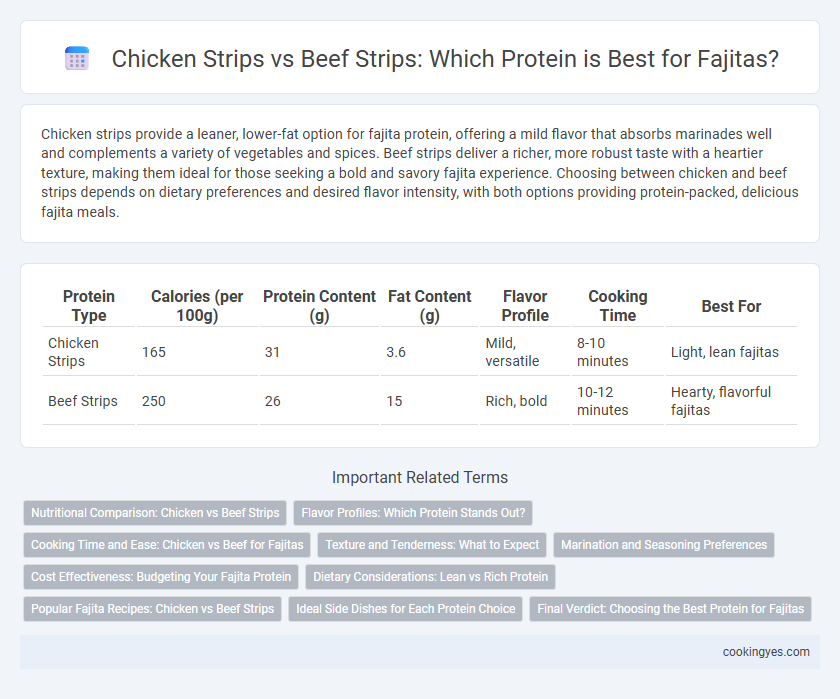Chicken strips provide a leaner, lower-fat option for fajita protein, offering a mild flavor that absorbs marinades well and complements a variety of vegetables and spices. Beef strips deliver a richer, more robust taste with a heartier texture, making them ideal for those seeking a bold and savory fajita experience. Choosing between chicken and beef strips depends on dietary preferences and desired flavor intensity, with both options providing protein-packed, delicious fajita meals.
Table of Comparison
| Protein Type | Calories (per 100g) | Protein Content (g) | Fat Content (g) | Flavor Profile | Cooking Time | Best For |
|---|---|---|---|---|---|---|
| Chicken Strips | 165 | 31 | 3.6 | Mild, versatile | 8-10 minutes | Light, lean fajitas |
| Beef Strips | 250 | 26 | 15 | Rich, bold | 10-12 minutes | Hearty, flavorful fajitas |
Nutritional Comparison: Chicken vs Beef Strips
Chicken strips for fajitas deliver leaner protein with lower saturated fat and calorie content compared to beef strips, making them a healthier option for weight-conscious individuals. Beef strips provide higher iron and zinc levels, essential minerals that support immune function and energy metabolism. Both protein choices offer beneficial amino acids, but chicken is preferred for heart health benefits while beef supports muscle repair with its richer nutrient profile.
Flavor Profiles: Which Protein Stands Out?
Chicken strips offer a mild, versatile flavor that readily absorbs fajita seasonings, resulting in a juicy and tender texture that complements spicy and smoky marinades well. Beef strips, particularly cuts like flank or skirt steak, provide a robust, savory taste with a rich umami profile that intensifies when seared, delivering a satisfying chew and depth of flavor. The choice between chicken and beef for fajita protein ultimately hinges on preference for lighter, subtler flavors versus bold, hearty meatiness.
Cooking Time and Ease: Chicken vs Beef for Fajitas
Chicken strips cook faster than beef strips, typically requiring about 5-7 minutes on high heat, making them ideal for quick fajita preparation. Beef strips often take 8-10 minutes to reach the desired tenderness, needing slightly more attention to avoid toughness. The ease of cooking chicken lies in its uniform texture and shorter cook time, while beef demands precise temperature control for optimal flavor and juiciness in fajitas.
Texture and Tenderness: What to Expect
Chicken strips in fajitas offer a tender, juicy texture with a mild flavor that easily absorbs marinades, creating a consistently soft bite. Beef strips provide a chewier, heartier texture with a richer, more robust taste, often requiring careful cooking to maintain tenderness. The choice between chicken and beef strips in fajitas depends on preferred texture balance and desired protein flavor intensity.
Marination and Seasoning Preferences
Chicken strips for fajitas benefit from a longer marination time, absorbing citrus-based marinades with garlic, cumin, and chili powder to enhance tenderness and flavor. Beef strips require a shorter marination, typically using a blend of soy sauce, lime juice, smoked paprika, and black pepper to maintain a robust, savory profile. Both proteins respond well to bold seasoning, but chicken tends to take on a more delicate, tangy character while beef offers a richer, earthier taste.
Cost Effectiveness: Budgeting Your Fajita Protein
Chicken strips for fajitas offer greater cost effectiveness compared to beef strips, often priced lower per pound while delivering high protein content and flavor versatility. Beef strips tend to be more expensive due to higher demand and quality grades but provide a richer taste that may justify the budget for some consumers. Opting for chicken strips can significantly reduce overall meal costs, making them ideal for budget-conscious fajita preparations without compromising on nutrition or satisfaction.
Dietary Considerations: Lean vs Rich Protein
Chicken strips are a lean protein choice for fajitas, offering lower fat content and fewer calories, making them ideal for those seeking a lighter meal. Beef strips provide a richer protein source with higher fat content, contributing to a more intense flavor but increased caloric intake. Dietary considerations often favor chicken for weight management and heart health, while beef may appeal to those needing higher iron and zinc levels.
Popular Fajita Recipes: Chicken vs Beef Strips
Chicken strips dominate popular fajita recipes due to their tender texture and ability to absorb bold marinades, enhancing flavors such as lime, garlic, and cumin. Beef strips offer a robust, savory profile preferred in traditional Tex-Mex fajitas, providing a hearty option with seasonings like chili powder and smoked paprika. Both proteins deliver distinct taste experiences, making them staples in versatile fajita preparations across restaurants and home kitchens.
Ideal Side Dishes for Each Protein Choice
Chicken strips pair perfectly with lighter sides like grilled vegetables, cilantro-lime rice, and fresh guacamole, complementing their mild flavor and tender texture. Beef strips, rich and savory, are best matched with hearty sides such as charred corn, black beans, and smoky chipotle salsa to enhance their robust taste. Choosing the right side dishes accentuates the distinct profiles of chicken and beef fajita proteins, creating a balanced and flavorful meal.
Final Verdict: Choosing the Best Protein for Fajitas
Chicken strips offer a leaner, milder flavor that easily absorbs fajita spices, making them ideal for a lighter, healthier meal. Beef strips provide a richer, more robust taste with a satisfying texture that complements traditional fajita seasoning and charred peppers. The best choice depends on preference for flavor intensity and nutritional goals, with chicken favored for low-fat content and beef preferred for hearty flavor.
Chicken strips vs Beef strips for Fajita protein Infographic

 cookingyes.com
cookingyes.com